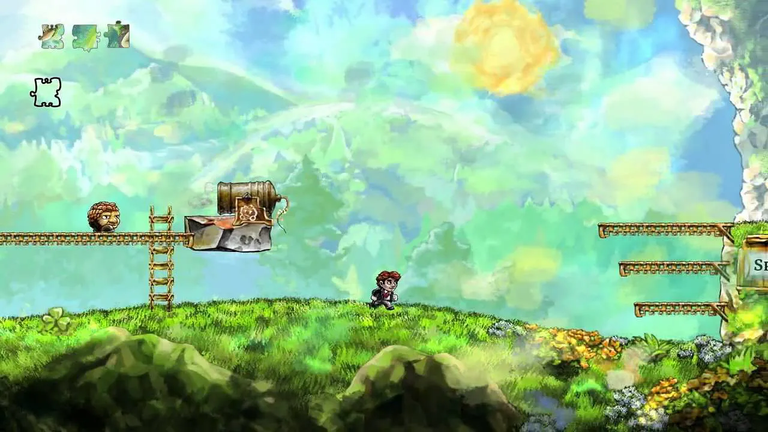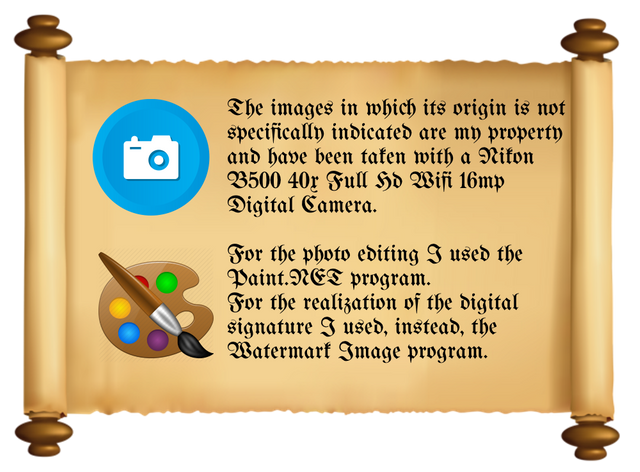
Braid is a platform and puzzle video game developed by Number None, Inc. The game was released on August 6, 2008 for the Xbox 360's Xbox Live Arcade service. A Microsoft Windows version was released on April 10, 2009. Hothead Games ported and released the game to Mac OS X on May 20, 2009 and the PlayStation Network on November 12, 2009. A Linux port, created by Ryan C. Gordon, was released December 14, 2010 as part of the second Humble Indie Bundle.
The basic story elements unfold as the protagonist, Tim, attempts to rescue a princess from a monster. Text passages laid throughout the game reveal a multifaceted narrative, giving clues about Tim's contemplations and motivations. The game features traditional aspects of the platform genre while integrating various powers of time-manipulation. Using these abilities, the player progresses by finding and assembling jigsaw puzzle pieces.
Jonathan Blow designed the game as a personal critique of contemporary trends in game development. He funded the three-year project with his own money. Webcomic artist David Hellman drew the artwork, which underwent several iterations until it satisfied Blow's vision. A preliminary version of Braid without the final artwork won the "Innovation in Game Design" award at the 2006 Independent Games Festival; the final version received additional accolades. The game received highly positive reviews from critics, eventually becoming the highest critically rated title on Xbox Live. Some reviewers, however, criticized the game's price relative to its length.
Braid is played by solving physical puzzles in a standard platform game environment.

The player controls the protagonist Tim as he runs, jumps, and climbs across the game's levels. Tim jumps and stomps on enemies to defeat them, and can collect keys to unlock doors or operate levers to trigger platforms. A defining game element is the player's unlimited ability to reverse time and "rewind" actions, even after dying. The game is divided into six worlds, which are experienced sequentially and can be entered from different rooms of Tim's house; the player can return to any world previously visited to attempt to solve puzzles they missed.
Each world has its own time-based game mechanic:
Time and Forgiveness plays as an ordinary platform game, except that the player may rewind time to undo their actions. The section includes several challenges that would be unplayable or unfair in an ordinary platform game, but become feasible when the rewind mechanic is available.
Time and Mystery introduces objects surrounded by a green glow that are unaffected by time manipulation; for example, switches will remain flipped even if time is rewound to before the action occurred. Rewinding can thus be used to change the synchronization between objects that can and cannot be rewound, the basis of many puzzles in this section. This theme is also used in later worlds to denote objects unaffected by the player's time manipulation.
Time and Place links the passage of time to the player character's location on the horizontal axis. As the player moves toward the right, time flows forward, while moving toward the left reverses the flow; standing still or moving vertically will pause time. The player's location must be carefully managed in relation to enemies and objects.
Time and Decision involves a "shadow" of the player character appearing after the player rewinds time and performing the actions that the real player character rewound; if the timeline expires, the shadow will complete any initiated falls and jumps but will otherwise stand still before disappearing. Things coloured in violet can interact both with the main character and its shadow at the same time. Puzzles in this section revolve around using this mechanic to carry out multiple actions at once.
Hesitance provides the player with a magic ring which, when dropped, warps the flow of time around itself; the closer moving objects (including Tim) are to it, the slower time passes for them. The regular rewind control remains available.
The final world is labeled simply as "1." In this world, time flows in reverse. Rewinding time returns the flow of time to its normal state.
Each stage contains puzzle pieces that must be collected to create jigsaw puzzles that tell the story, and to unlock the last stage. On completing the main game, a speedrun mode becomes available for select levels and the entire game. There are also eight stars hidden throughout the world of Braid that correspond to the stars in the constellation of Andromeda just outside the main character's house.

Braid es un videojuego de plataformas y rompecabezas desarrollado por Number None, Inc. El juego se lanzó el 6 de agosto de 2008 para el servicio Xbox Live Arcade de Xbox 360. Se lanzó una versión para Microsoft Windows el 10 de abril de 2009. Hothead Games adaptó y lanzó el juego para Mac OS X el 20 de mayo de 2009 y para PlayStation Network el 12 de noviembre de 2009. Un puerto para Linux, creado por Ryan C. Gordon, se lanzó el 14 de diciembre de 2010 como parte del segundo Humble Indie Bundle.
Los elementos básicos de la historia se desarrollan a medida que el protagonista, Tim, intenta rescatar a una princesa de un monstruo. Los pasajes de texto que se encuentran a lo largo del juego revelan una narrativa multifacética, que da pistas sobre las reflexiones y motivaciones de Tim. El juego presenta aspectos tradicionales del género de plataformas al tiempo que integra varios poderes de manipulación del tiempo. Usando estas habilidades, el jugador progresa encontrando y ensamblando piezas de rompecabezas.
Jonathan Blow diseñó el juego como una crítica personal de las tendencias contemporáneas en el desarrollo de juegos. Financió el proyecto de tres años con su propio dinero. El artista de webcómics David Hellman dibujó la obra de arte, que pasó por varias iteraciones hasta que satisfizo la visión de Blow. Una versión preliminar de Braid sin la obra de arte final ganó el premio "Innovación en el diseño de juegos" en el Festival de Juegos Independientes de 2006; la versión final recibió elogios adicionales. El juego recibió críticas muy positivas de los críticos, y finalmente se convirtió en el título mejor calificado por la crítica en Xbox Live. Sin embargo, algunos críticos criticaron el precio del juego en relación con su duración.
Braid se juega resolviendo rompecabezas físicos en un entorno de juego de plataformas estándar.

El jugador controla al protagonista Tim mientras corre, salta y trepa por los niveles del juego. Tim salta y pisotea a los enemigos para derrotarlos, y puede recolectar llaves para desbloquear puertas o accionar palancas para activar plataformas. Un elemento que define el juego es la capacidad ilimitada del jugador para revertir el tiempo y "rebobinar" acciones, incluso después de morir. El juego está dividido en seis mundos, que se experimentan de forma secuencial y a los que se puede ingresar desde diferentes habitaciones de la casa de Tim; el jugador puede regresar a cualquier mundo visitado previamente para intentar resolver los acertijos que se perdió.
Cada mundo tiene su propia mecánica de juego basada en el tiempo:
Time and Forgiveness se juega como un juego de plataformas normal, excepto que el jugador puede rebobinar el tiempo para deshacer sus acciones. La sección incluye varios desafíos que serían injugables o injustos en un juego de plataformas normal, pero se vuelven factibles cuando la mecánica de rebobinado está disponible.
Time and Mystery presenta objetos rodeados de un brillo verde que no se ven afectados por la manipulación del tiempo; por ejemplo, los interruptores permanecerán activados incluso si se rebobina el tiempo hasta antes de que ocurriera la acción. Por lo tanto, el rebobinado se puede utilizar para cambiar la sincronización entre los objetos que se pueden y no se pueden rebobinar, la base de muchos acertijos en esta sección. Este tema también se utiliza en mundos posteriores para denotar objetos que no se ven afectados por la manipulación del tiempo por parte del jugador.
El tiempo y el lugar vinculan el paso del tiempo con la ubicación del personaje del jugador en el eje horizontal. A medida que el jugador se mueve hacia la derecha, el tiempo fluye hacia adelante, mientras que moverse hacia la izquierda invierte el flujo; quedarse quieto o moverse verticalmente detendrá el tiempo. La ubicación del jugador debe gestionarse con cuidado en relación con los enemigos y los objetos
El tiempo y la decisión implica una "sombra" del personaje del jugador que aparece después de que el jugador rebobine el tiempo y realice las acciones que el personaje del jugador real rebobinó; si la línea de tiempo expira, la sombra completará cualquier caída y salto iniciados, pero por lo demás se quedará quieta antes de desaparecer. Las cosas coloreadas en violeta pueden interactuar tanto con el personaje principal como con su sombra al mismo tiempo. Los acertijos de esta sección giran en torno al uso de esta mecánica para realizar múltiples acciones a la vez.
La vacilación proporciona al jugador un anillo mágico que, cuando se deja caer, deforma el flujo del tiempo a su alrededor; cuanto más cerca estén los objetos en movimiento (incluido Tim), más lento pasará el tiempo para ellos. El control de rebobinado normal sigue estando disponible.
El mundo final está etiquetado simplemente como "1". En este mundo, el tiempo fluye en sentido inverso. Al rebobinar el tiempo, el flujo del tiempo vuelve a su estado normal.
Cada etapa contiene piezas de rompecabezas que se deben recolectar para crear rompecabezas que cuenten la historia y para desbloquear la última etapa. Al completar el juego principal, se activa un modo de carrera rápida para niveles seleccionados y para todo el juego. También hay ocho estrellas ocultas en todo el mundo de Braid que corresponden a las estrellas de la constelación de Andrómeda, justo afuera de la casa del personaje principal.


Graciar por leer!
Hasta el próximo juego #gamers e #blurtians de esta querida comunidad!
Thank you for reading!
Until the next game #gamers and #blurtians of this beloved community!Until the next game #gamers and #blurtians of this beloved community!
Sources / Fuentes:
- Capturas de pantallas / Screenshots /: Braid.

Upvoted. Thank You for sending some of your rewards to @null. Get more BLURT:
@ mariuszkarowski/how-to-get-automatic-upvote-from-my-accounts@ blurtbooster/blurt-booster-introduction-rules-and-guidelines-1699999662965@ nalexadre/blurt-nexus-creating-an-affiliate-account-1700008765859@ kryptodenno - win BLURT POWER delegationNote: This bot will not vote on AI-generated content
Thanks @ctime.
Telegram and Whatsapp
Thanks!!
Telegram and Whatsapp
Thanks!!